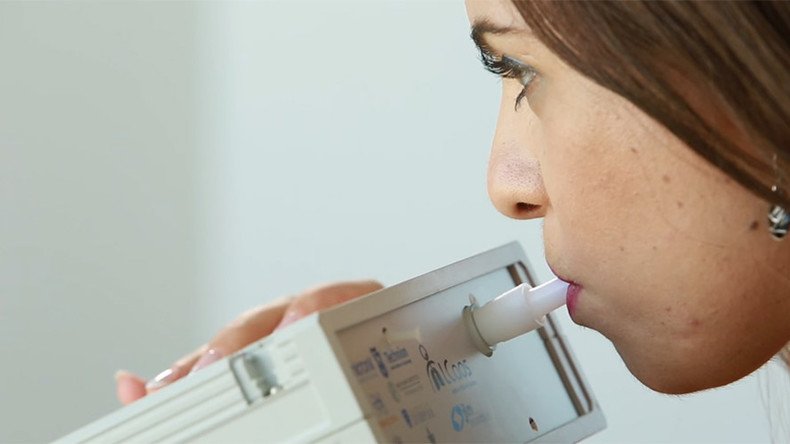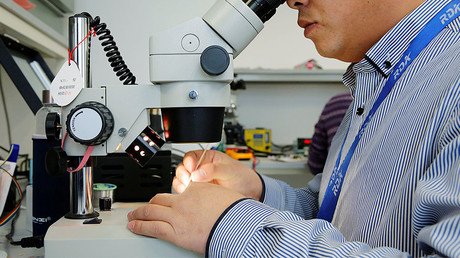‘Unique breathprint’: Scientists develop device able to ‘sniff out’ 17 deadly diseases

An international team of researchers has developed a unique device that can detect and distinguish between as many as 17 illnesses, ranging from multiple sclerosis to several types of cancer, on the basis of a breath sample.
The team, led by a group of scientists from the Israel Institute of Technology, has created a Nano-array composed of carbon nanotubes and tiny gold particles controlled by a special AI program that is able to detect specific components in human breath samples and distinguish between unique chemical signatures depending on the patient’s state of heath.
The findings of their study were published in the US ACS Nano journal on Wednesday.
Every time people exhale, they expel not only nitrogen, carbon dioxide, and oxygen, but also more than 100 unique chemicals called volatile organic compounds (VOCs). Their composition and concentration depends on the person’s health condition.
The team managed to prove that every disease has a specific signature reflected in the composition of the VOCs a person exhales. Using mass spectrometry, they found that each disease, out of the 17 included in the research, produces a unique VOC breathprint based on differing amounts of 13 components.
“Just as each of us has a unique fingerprint that distinguishes us from others, each disease has a chemical signature that distinguishes it from other diseases and from a normal state of health,” Hossam Haick, a professor in the chemical engineering department and the Russell Berrie Nanotechnology Institute at the Technion, Israel, and lead researcher of the project, said.
“These odor signatures are what enables us to identify the diseases using the technology that we developed,” he added.
The researchers collected and tested more than 2,800 breath samples taken from 1,404 people in the United States, Israel, France, Latvia, and China over three years. More than 800 patients taking part in the study had at least one of the 17 different diseases that were analyzed, while the rest were healthy.
The list of illnesses, the signatures of which the scientists were able to successfully detect in the patients’ breath samples, includes chronic kidney failure, two forms of Parkinson's disease, multiple sclerosis, Crohn’s disease, ulcerative colitis, irritable bowel syndrome, high blood pressure, and eight different types of cancer.
The system was able to identify a disease with an accuracy of 86 percent, according to the developers. The accuracy of the test results can be affected by the patient’s gender, age, smoking habits, and geographic location, the scientists admitted, adding that these factors do not impair the general sensitivity of the array.
It is not the first attempt to create a device that can detect a disease based on breath samples, although all prototypes that have been created earlier were able only to detect one kind of illness of a specific type like cancer or diabetes, and could not distinguish between different diseases in a sample.
The device created by the team is capable of detecting several diseases in one sample at the same time, and the presence of one disease does not prevent the detection of others. Professor Haick said that the working principle of the device was based on the way dogs recognize a scent.
“We can teach the system that a breathprint could be associated with a particular disease,” Haick told Smithsonian.com, adding that “it works in the same way we'd use dogs in order to detect specific compounds. We bring something to the nose of a dog, and the dog will transfer that chemical mixture to an electrical signature and provide it to the brain, and then memorize it in specific regions of the brain.”
“We let it smell a given disease but instead of a nose we use chemical sensors, and instead of the brain we use the algorithms. Then in the future, it can recognize the disease as a dog might recognize a scent,” he said.
The technology developed by the team is already licensed and will potentially be available for medical use in five years. The scientists are now working on making the device inexpensive and portable, saying it could eventually cost around $30. The device is also expected to become an ultimate diagnostic test, as it is painless and could deliver results in a short period of time.
“Breath is an excellent raw material for diagnosis. It is available without the need for invasive and unpleasant procedures, it's not dangerous, and you can sample it again and again if necessary,” Haick said, adding that the new method could replace such diagnostic procedures as biopsy and could be used to detect early-stage diseases, thus increasing the chances of survival, New Atlas reports.














